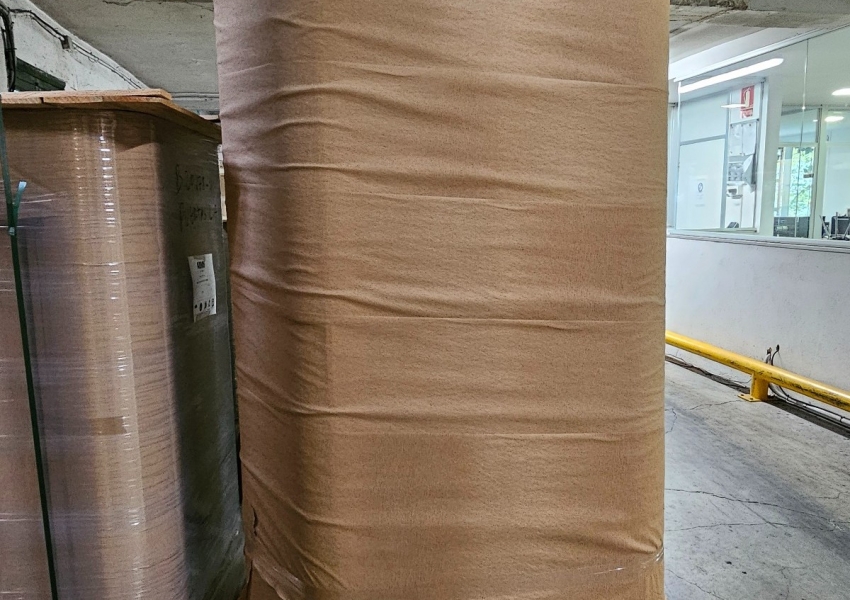What is Crepe Paper?
Crepe paper is a type of treated paper that has a crinkled and elastic texture. This treatment enhances its flexibility and durability, making it ideal for protecting and wrapping fragile or delicate items. Made primarily from natural fibers, such as cellulose, crepe paper is biodegradable, recyclable, and compostable. These characteristics align it perfectly with sustainable packaging principles.
The Importance of Sustainable Packaging
The packaging industry has been identified as one of the largest contributors to plastic waste, a global issue that affects biodiversity and climate change. Sustainable packaging is a response to these challenges, offering solutions that reduce environmental impact. This type of packaging, like crepe paper, allows companies to reduce their carbon footprint and align with consumer expectations, who increasingly prefer eco-friendly and responsible products.
Opting for sustainable packaging means minimizing the use of non-recyclable materials and choosing those that can be reused, recycled, or biodegraded without leaving a negative footprint on the environment.
Benefits of Crepe Paper in Sustainable Packaging
- Biodegradable and Recyclable:
One of the main advantages of crepe paper is its ability to naturally decompose. Once discarded, it breaks down quickly without releasing toxic substances. Additionally, crepe paper can be recycled, which extends its lifespan and reduces the need to extract virgin resources for new packaging materials. - Plastic Alternative:
Sustainable packaging aims to reduce or eliminate the use of plastics and other petroleum-based materials that are harmful to the environment. Crepe paper is an excellent alternative to bubble wrap, offering the same protection for fragile products without long-term contaminating effects. - Flexibility and Strength:
The creping process gives the paper an elastic texture that allows it to adapt to products of various shapes and sizes. This ability to conform to different objects makes it a versatile option in packaging, protecting even the most delicate items. - Lightweight and Easy to Use:
Crepe paper is lightweight, reducing both cost and environmental impact associated with transportation. It is also easy to handle, cut, and adjust, making it convenient for various packaging applications, from product protection to box filling. - Visually Attractive and Eco-Friendly:
Beyond its functional benefits, crepe paper offers a natural aesthetic that is highly appealing in today’s market. Its visual appeal and eco-friendliness help brands communicate their sustainability values through their packaging.
Uses of Crepe Paper in Sustainable Packaging
Crepe paper has a wide range of applications in sustainable packaging, from protecting delicate products to decorative presentations. Some main uses include:
- Protection for Fragile Products:
The elasticity of crepe paper makes it ideal for wrapping delicate items such as ceramics, glass, or electronics. Its impact absorption and vibration-damping capabilities make it a sustainable alternative to bubble wrap or expanded polystyrene during transport. - Food Packaging:
Thanks to its natural composition, crepe paper can be safely used in food packaging. This makes it a sustainable option for wrapping fresh or delicate items like fruits, vegetables, or baked goods, without the risk of chemical contamination. - Box and Gift Basket Filler:
Another common application of crepe paper is as filler material in shipping boxes or gift baskets. Its texture and elasticity protect products from shocks and movement during transit, while also adding a natural aesthetic touch. - Wrapping and Decorations:
Crepe paper is also used in designing wrappers and displays for artisanal products or gifts. Its unique crinkled texture adds value to visual presentations, offering a rustic and elegant look that consumers associate with eco-friendly and sustainable products.
Comparison with Other Packaging Materials
In sustainable packaging, crepe paper stands out above many traditional materials, such as plastic or polystyrene. While these materials are effective in protecting products, they generate waste that takes centuries to decompose. Furthermore, expanded polystyrene (EPS), commonly used in fragile product transport, is difficult to recycle and takes up significant landfill space.
In contrast, crepe paper is not only more eco-friendly but also more versatile. Being recyclable and biodegradable, it significantly contributes to waste reduction and a more circular economy.
Crepe Paper and the Circular Economy
Crepe paper is an excellent example of how packaging materials can align with circular economy principles. Instead of following a linear "use and dispose" model, sustainable packaging seeks to extend the lifespan of materials through recycling and reuse. This minimizes waste and maximizes resource efficiency.
Many companies are adopting strategies to collect and reuse packaging after its use, fostering a continuous material cycle. By choosing packaging like crepe paper, companies can reduce their reliance on non-renewable resources and decrease the amount of waste they generate.
Future Prospects of Sustainable Packaging
With increased regulations on plastic use and the growing demand for eco-friendly packaging, crepe paper has a promising future in sustainable packaging. Many companies are adopting more environmentally friendly solutions, not only due to regulatory pressures but also in response to the expectations of more conscious consumers.
In the future, it is expected that crepe paper and other sustainable materials will become standard for the packaging industry, gradually replacing non-biodegradable materials. Additionally, the development of new technologies and production processes may further enhance the properties of crepe paper, making it more durable and adaptable to various packaging needs.
Conclusion
Crepe paper offers an eco-friendly, efficient, and versatile packaging solution that fits perfectly within the concept of sustainable packaging. Its biodegradable and recyclable characteristics, along with its ability to protect fragile products, make it an ideal choice for both companies and consumers looking to reduce their environmental impact. By adopting materials like crepe paper, we are one step closer to a future where packaging is not a burden on the planet but a sustainable solution that cares for it.




